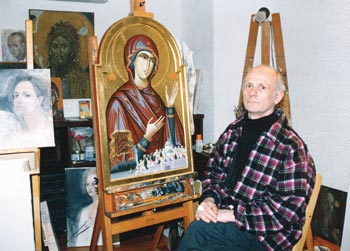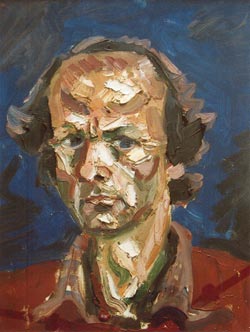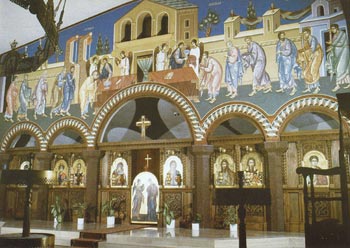| Ars sacra
MASTER OF ARTS, DRAGOMIR JAŠOVIĆ, THE PAINTER, THE ”NEW ASTRAPA OF MODERN ORTHODOX ICONOGRAPHY
Following the great masters
Forever marked by its homeland, Kosovo and Metohia, he spent the most of his life on scaffolding, with the saint whose faces emerged in front of him, with his paintbrush. He gave them the appearance of human beings which stand in front of us not only as illustration of a book but as living sermons which are fixing in our mind, in our heart
By: Ranka Stanišić
 From the stone of the unique and beautiful Rugavska Gorge emerges the water from Pećka Bistrica. On the other side of Peć, on the road to Rožaje, near the Village of Siga, in Radavac, is the spring of Beli Drim with little waterfalls. On the road to Prizren, you can see Visoki Dečani in the pine tree woods, beside Dečanska Bistrica, with a mineral water spring on its property. At the bottom of Rugova: The Patriarchate of Peć. The beautiful nature is fixed in the memory of every visitor... From the stone of the unique and beautiful Rugavska Gorge emerges the water from Pećka Bistrica. On the other side of Peć, on the road to Rožaje, near the Village of Siga, in Radavac, is the spring of Beli Drim with little waterfalls. On the road to Prizren, you can see Visoki Dečani in the pine tree woods, beside Dečanska Bistrica, with a mineral water spring on its property. At the bottom of Rugova: The Patriarchate of Peć. The beautiful nature is fixed in the memory of every visitor...
In these surroundings, 70 years ago, a prolific painter Dragomir Jašović-Jaša was born, talented and diligent. He got into Secondary Art School in Peć which was prestigious and reserved only for the really talented ones. He continued his education in Belgrade, on the Arts Academy, and his graduate studies with Professor Milo Milunović, department for wall painting.
As a student, he took part in cleaning and conserving Serbian medieval frescos under the protection of the Institute for the Protection of Cultual Monuments of Serbia, managed by the painter Brana Živković. Živković was the one to encourage young assistants in copying frescos during the pauses between working. After that, Dragomir Jašović worked for the Gallery of Frescos for 15 years as a collaborator and gave a great contribution to the preservation of Serbian medieval cultural heritage and its better representing around the world. Besides Zdenka Živković, he is our best copyist.
Jašović understood the essence of medieval painting, technically and artistically, and while we look at his copies we are making a total communication with the authentic painting. It happened that when the Gallery of Frescos took over the work they were not sure of whether it was a copy and or an original.
Copying frescos from several periods, Jaša easily understood differences between totalities, following the continuity in cherishing the Serbian spiritual and historical epos and our national being. His copies reached the World Exhibition in Montréal, and his work was seen in Moscow, New York, Tokio, and Paris...
Love towards the protection of the artistic and cultural heritage is reflected on his total work. He tried all techniques of fine arts and he got stuck with three categories: oil (copies), paintings of churches and icons, watercolor work. The coloring of his native region, fixed in the unconsciousness, is expressed in his work no matter the technique.
A CHEERFUL DAY AND MONUMENTAL SILENCE  For the catalogue of Jašović’s first exhibition, in 1966, his professor Mio Milunović wrote: For the catalogue of Jašović’s first exhibition, in 1966, his professor Mio Milunović wrote:
”Dragomir Jašović represented himself with his first exhibition, with not much effort, as a painter who is the master of artistic laws. The technical side of his expression he learned during his studies. However, the thing that he couldn’t learn from someone, which is the essence of artistic creation, is the spirit which he carries inside him. His psyche and his world have no morbid parts. That is how we got the impression of a cheerful day, of monumental silence, transposed on his painting with the language of pure artistic expression.”
The motives on oil paintings of Jašović emerge from natural phenomenon, transforming them into an artistic experience with a little empiric sense and associations, the thing which connects the creator and the observer. A stirred up sky, vegetation from the stone, old tree stumps, the riverbed or Bistrica and Piva, hollow rocks — all of this filled the imagination and moved this painter. The materialization of this idea, born in contact with the rocky karsts, dry vegetation or cheerful clouds, got a full expression on Jašović’s paintings, got the fullness and the firmness.
Jašović spent the most of his life on scaffolds, sometimes in impossible conditions: under a tent on the church graveyard, in rented hovels, or in hotels. It doesn’t matter. But he never went anywhere without his water colors and paper. In pauses of copying icons or painting the church, he went into the nature and painter watercolors. Those were motives of the Mediterranean landscape, church architecture with its surroundings, dense vegetation, olive groves, archaeological localities... painted very quickly, in an instant, fresh and rich in color, typical for his painting.
”For the watercolor, it is important to have a good eye, good observation, a quick and confident move and to focus on the selected area which attracts me. Not many people use this technique, even if it looks easy and quick, it is really very hard to how that much in only a few moves, to clearly catch the one moment of nature, the unrepeatable moment fixed in consciousness. One should not only copy the sight, because he could penetrate into trash.”
Jašović should thank Professor Vlada Radević from Peć, a great watercolor artist who taught in High School, for his love towards watercolor. He took the everyday to the churchyard of the Patriarchate of Peć, in Visoki Dečani or in an old district of Peć with twisted roof tops of houses surrounded by thick earthen walls.
In the area of Kosovo and Metohia, in the surroundings of the most important Serbian myth, it is not surprising that Jašović became a very spiritual person in his young age. The religious character of a man is understood in such a surrounding. Dragomir Jašović also came from a very deeply Orthodox family. As a boy, he admired the frescos of the Patriarchate of Peć and Dečani, the written history of the origin, the glory and the martyrdom of saints, and the history through the Nemanjić dynasty. At the same time, he looked at the white walls in a small village church in his native Siga and he promised that one day he shall paint it. But, the church was torn down and it is still waiting to be renovated. Jašović is also waiting to fulfill his promise.
OUR INNER CHURCH  He first painted the church when Abbes Paraskeva invited him to Manasija to paint the chapel in the palace. He prepared for it very seriously; he even had a special journey through Orthodox countries. He first painted the church when Abbes Paraskeva invited him to Manasija to paint the chapel in the palace. He prepared for it very seriously; he even had a special journey through Orthodox countries.
After painting the chapel in Manasija, there were invitations from Jerisos
(Kakovo, the land of Chilandar), Monastery Zlatenica near Svilajnac, then the invitation to paint the Church of St. Marina in Donje Vidovo, then the Church of the Holy Mother of God (a monastery) near Ohrid, churches is Malmö, Dusseldorf, Ljubljana, Zenica. The war in Yugoslavia prevented him from finishing the work in a church in the center of Zagreb (he finished the altar part).
”I would mention the church dedicated to the Protecting Veil of the Mother of God in Đunis”, says Dragomir Jašović for the National Review. ”Instead of the color background I put 20 carat gold, on 30 percent of space. The man feels like he is in Heaven. The endless purity and light are ascending us.”
He also mentions the Monastery St.Lidia in Asprovalta in Greece and Father Teofil, the Greek who is proudly carrying the medal of a Serbian knight. He deserved the medal for taking care of Serbian wounded people and Serbian orphans from the last war. When they asked him why does he like Serbs, when they were giving him the medal, he said: ”Yesterday, they took my blood at the doctor’s, for some control, and the doctor told me that I have 50 percent of Serbian blood.”
Master Jašović worked in Cyprus, for the Monastery Kykkos which is wealthier that the whole country.
”Times have changed”, he says. ”Sometimes, the Greek worked for our rulers and landowners. After the weakening of Byzantium, Serbian was rising and the Serbian landowners could get the best painters from Constantinople and Thessaloniki, which is proved with the frescos of Sopoćani, Mileševa, Đurđevi stupovi... In general, it is the same, whether you work for the Greek or the Serbian monasteries. What matters the most for me is that the scaffolding is firm and good. I am always participating in building the scaffolding; when we manage that, everything else is easy. As for the iconography, I know better the Serbian saints. But, it is not hard for me to study the life of the Greek saint that I should paint, and I paint him according to my own vision. I did the same thing when Metropolitan Amfilohije Radović invited me to paint the icon of St. Peter of Cetinje. It was his first icon and it can be the model for the next ones.”
He remembers painting the Church of St. Peter and Paul in Petrovaradin, the chapel in the Monastery Grgeteg on Fruška Gora, Monastery Rajinovac in Begaljica, near Belgrade.
”Rajinovac is not the last church, but I remember Mother Minadora. I started painting in 1993 and I have finished the altar part and then, on the request of Bishop of Niš, Irinej, I had to stop and I had to take another job. I thought that someone else will finish the painting in Rajinovac, but Mother Minadora wanted me and she waited for almost eight years, Then, I finished the painting, on mutual satisfaction.”
THE LIVING PAINTED SERMON Jašović, ”the Astrapa of our times”, as his Macedonian friends called him, painted hundreds of icons.
”When I started painting icons, in ex-Yugoslavia, in Serbia, it was still during the time of aggressive atheism. Therefore, this job demanded quite a personal courage. There was always a battle going on with those iconoclasts.”
Jašović’s icons are much different from the ”present production of new sacral art”. Tender shapes of saint characters, the harmony of color, the sense of rhythm, the sublime and spiritual forms in which there is human and divine at the same time, don’t even leave even the atheists indifferent.
”Since the Middle Ages, it happened the several frescos, especially the one from first zones, the closest to the observer, such as portraits of endowers and some of the most important saints, can be painted so detailed, as an icon, It happens that a fresco associates to an icon, while the opposite is much uncommon”, says Aleksandra Davidov-Temereinski about Jašović’s icon painting. ”Jaša’s icons have some monumental classicism of our fresco painting from the 13th century. The characters of saints are beautifully made, one can even see the sensuality, with which they come closer to the well educated taste of the observer from our times which knows the works of art of the Byzantine: mosaics of Constantinople from different epoch, mosaics of Rotonda in Thessaloniki from the early Christian period as well as wall painting of Mileševa and Spopoćani.”
Nearly mummificated characters of saints, full of asceticism and stoicism, get a new physiognomy of human beings painted with the author’s technique, palette and brush, stand before us as illustrations of a book, as a living sermon, as a inexhaustible spring of East which quench one’s thirst and fixing in our mind, in our heart. |
